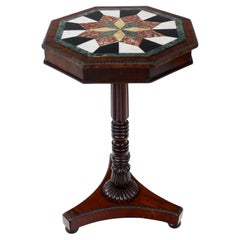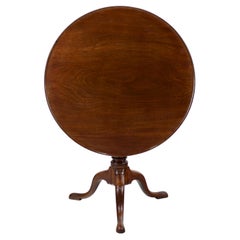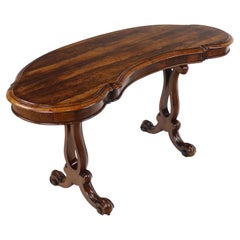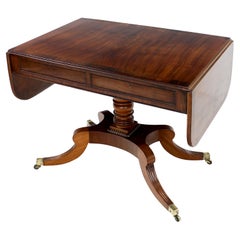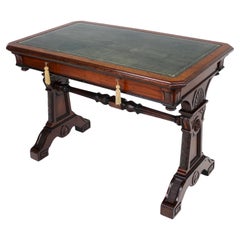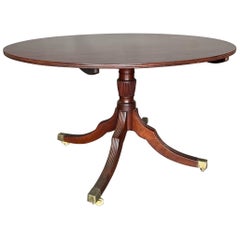The Antique Furniture Company Tables
to
Height
to
Width
to
Depth
to
20
20
11
6
1
1
1
18
1
1
19
15
13
7
6
20
14
8
4
4
20
20
20
Antique English Regency Marble Specimen & Mahogany Table
By Gillows of Lancaster & London
Located in Glasgow, GB
An antique Regency mahogany and specimen marble occasional table, attributable to Gillows of Lancaster and dating to c.1830. The mahogany crossbanded octagonal top with a beaded ed...
Category
Antique 19th Century English Regency Tables
Materials
Marble
Antique Scottish William IV Oak Hall or Serving Table
Located in Glasgow, GB
A large Scottish William IV oak hall or serving table dating to the early 19th century, circa 1830. With a moulded rectangular top above a shaped frieze with central shield cartouch...
Category
Antique 19th Century Scottish William IV Console Tables
Materials
Oak
Antique English 18th Century Early Georgian Dish Top Bird Cage Tripod Table
Located in Glasgow, GB
A handsome 18th century early Georgian mahogany tripod tea table with a dish top. It features a solid figured mahogany circular tilt-top with single reeded line to the outer curved edge, with a bird cage mechanism to a turned baluster shaped column raised on outswept cabriole legs with pad feet. Retaining a good original colour and patination and original brass catch.
This is a better quality example of its type being moderately larger, the top being from a single piece of mahogany and having the slight lip to the outer edge, due to the dish top, and curved underedge, in addition the birdcage mechanism lets the top rotate without lifting the entire table. The tilt-top allows the table to be displayed at the side of the room when not in use (and the birdcage also means the top can be faced out with the legs arranged pointing into a corner, or flat against a wall). This is a typically plain and robust George II example dating to c.1730-1750.
The overall dimensions at the largest points are approximately
Width - 33.865in (86cm)
Depth - 33.75in (85.5cm)
Height - 28.75 (73cm)
The top can be separated from the base by removal of a wedge in the birdcage.
Note:
The tripod table (or ‘pillar and claw...
Category
Antique 18th Century English George II Dessert Tables and Tilt-top Tables
Materials
Brass
Antique English Victorian Rosewood Kidney Shaped Writing Table
Located in Glasgow, GB
A freestanding Victorian rosewood kidney shaped writing or centre table with attractive scroll shaping to the top and cross grain double mouldings to the edge. The cross banded frie...
Category
Antique 19th Century English Victorian Desks and Writing Tables
Materials
Brass
Antique Scottish Mahogany & Rosewood Crossbanded Sofa Table
By William Trotter
Located in Glasgow, GB
A Regency Scottish sofa table attributed to William Trotter of Edinburgh. The richly figured mahogany top with a rosewood crossbanded edge and D-end dr...
Category
Antique Early 19th Century Scottish Regency Sofa Tables
Materials
Brass
Regency Neoclassical Mahogany Library Table in the manner of Richard Bridgen
By Richard Bridgens
Located in Glasgow, GB
A superb quality late Regency mahogany and ebonised library table in the manner of the architect and designer Richard Bridgens (1785-1846). With a canted top with a green and gilt t...
Category
Antique Early 19th Century English Regency Desks and Writing Tables
Materials
Brass
Irish Antique Regency Burr Yew Drop-Leaf Work or Sewing Table, 19th Century
Located in Glasgow, GB
A rare Regency period burr yew and inlaid drop-leaf work table dating to c.1820. This attractive table has tulipwood crossbanding to the top and a U-shaped cradle support on a recta...
Category
Antique 1820s Irish Regency Tables
Materials
Brass
Pair of Antique French 19th Century Marquetry Inlaid Étagères
Located in Glasgow, GB
A stylish pair of French marquetry inlaid étagères dating to circa 1860. Each with three shelves featuring intricate marquetry in walnut, boxwood and ebonised inlays depicting music...
Category
Antique 19th Century French Victorian Tables
Materials
Brass
A late 19th Century French Napolean III Marquetry Poudreuse or Work Table
Located in Glasgow, GB
An elegant French Napolean III marquetry podreuse or work table dating to the late 19th century. The hinged top inlaid in the rococo style with amboyna and satinwood to depict flora...
Category
Antique Late 19th Century French Louis XV Tables
Materials
Birdseye Maple, Satinwood, Walnut, Amboyna
Pair of Antique Scottish Regency Mahogany Pedestal Wine or Occasional Tables
Located in Glasgow, GB
A pair of Scottish Regency mahogany occasional or wine tables, possibly by James Mein of Kelso, and dating to c.1825. Each with a solid mahogany rounded rectangular top supported by a ring turned column on a tripartite concave platform base with turned boss to the column and raised on gadrooned feet. It should also be noted the distinctive Scottish 'honey-pot' baluster turning to the column is a characteristic of James & Matthew Morison of Ayr’s commissions for Sir David Hunter...
Category
Antique Early 19th Century Scottish Regency Side Tables
Materials
Mahogany
Large Victorian Style Mahogany Circular Centre Table - 6ft7 / 2m diameter
Located in Glasgow, GB
A large 6ft 7in / 2m diameter Victorian style solid mahogany centre, the circular top with a moulded edge and frieze and raised on an acanthus carved column with four downswept legs ...
Category
Mid-20th Century British Victorian Center Tables
Materials
Mahogany
Early Victorian Extra Wide Oak Dining Table and Six Leaves, Seats 18
Located in Glasgow, GB
Superb quality extra wide early Victorian extending dining table in golden quarter-sawn oak with six original leaves. Dating to circa 1840 this unusually large 62 1/2in wide table...
Category
Antique Mid-19th Century English Early Victorian Dining Room Tables
Materials
Brass
Antique English Victorian Burr Walnut & Floral Marquetry Demi-Lune Card Table
Located in Glasgow, GB
An attractive `Victorian walnut and marquetry demi-lune card table dating to circa 1870. The fold-over top inlaid with sprays of flowers within scrolling borders, with a thumb mould...
Category
Antique 19th Century English Victorian Card Tables and Tea Tables
Materials
Brass
Antique Scottish Regency Rosewood Tea Table in the Manner of William Trotter
By William Trotter
Located in Glasgow, GB
A Scottish Regency rosewood tea table, circa 1820, attributed to William Trotter of Edinburgh. The rectangular crossbanded top above a frieze with typi...
Category
Antique Early 19th Century Scottish Regency Card Tables and Tea Tables
Materials
Brass
Antique English Victorian Mahogany Extending Dining Table & 3 Leaves, Seats 12
Located in Glasgow, GB
A super quality antique Victorian flame mahogany wind-out extending dining table with three additional leaves and standing on four baluster shaped legs. This 4ft6 wide table smoothly...
Category
Antique 19th Century British Victorian Dining Room Tables
Materials
Brass
Antique English Victorian Mahogany Extending Dining Table and 4 Leaves, Seats 16
Located in Glasgow, GB
A super quality antique Victorian mahogany wind-out extending dining table with four additional leaves and standing on six substantial legs. This large 4ft9 wide table smoothly exten...
Category
Antique 19th Century English Victorian Dining Room Tables
Materials
Metal
Pair of Antique Irish Victorian Burr Walnut and Carved Card Tables
Located in Glasgow, GB
Stunning pair of 19th century Irish burr walnut cards tables, the serpentine shaped tops with highly figured bookmatched veneers and ‘Irish carved’ edge of trailing Shamrocks, leaves...
Category
Antique 19th Century Irish Victorian Card Tables and Tea Tables
Materials
Brass
Rare Antique Victorian Irish Killarney Ware Nest of Marquetry Tables
Located in Glasgow, GB
A very rare nest of three Irish Killarney ware arbutus and yew marquetry tables dating to the mid-19th century. Each inlaid to the tops with ferns and t...
Category
Antique Mid-19th Century Irish Victorian Nesting Tables and Stacking Tables
Materials
Other
Antique Victorian Irish Killarney Work Arbutus Marquetry Inlaid Work Table
Located in Glasgow, GB
An exceptional quality Irish Killarney ware arbutus work table inlaid throughout with shamrocks, thistles and roses. The shaped octagonal top with radia...
Category
Antique Mid-19th Century Irish Victorian Industrial and Work Tables
Materials
Brass
Antique Victorian Cuban Mahogany Extending Dining Table & Three Leaves, Seats 12
Located in Glasgow, GB
A super Victorian extending dining table in figured Cuban mahogany and with three additional leaves. Dating to circa 1870 this classic is of the rarer oval ended shape with a moulded...
Category
Antique 1870s English Victorian Dining Room Tables
Materials
Brass
Related Items
19th Century English Regency period oval mahogany breakfast table
Located in Richmond, VA
19th century English Regency period oval mahogany breakfast table or center table. Fabulous color and grain top, nice reeded legs and original castors.
Category
Antique 19th Century English Regency Tables
Materials
Mahogany
Antique English Table Hall Entry Console Sofa Table Oak William & Mary c. 1900
Located in Tyler, TX
CHARMING Antique English William & Mary Oak Entry Table, Hall Table, Sofa Table or Console Table with Drawers~~c. 1900-1910
Excellent oak table with t...
Category
Antique Early 1900s English William and Mary Console Tables
Materials
Oak
$3,525
H 32.75 in W 50.5 in D 17.5 in
English Mahogany Tripod Table - 18th Century
Located in Brussels, Brussels
Elegant English tripod table in solid mahogany from the 18th century
Small model which has a superb solid mahogany top with a beautiful flame
Tripod base in solid mahogany with very...
Category
Antique 18th Century British Georgian Dessert Tables and Tilt-top Tables
Materials
Mahogany
Antique Hall Table, Scottish, Oak, Side, Reception, Gothic Revival, Victorian
Located in Hele, Devon, GB
This is an antique hall table. A Scottish, oak side table with Gothic revival taste, dating to the late Victorian period, circa 1880.
Attractive example of fine 19th century Scottish furniture...
Category
Antique Late 19th Century Scottish Late Victorian Console Tables
Materials
Oak
$4,882
H 30.12 in W 36.03 in D 17.92 in
Antique Victorian Leather Top Desk / Writing Table
Located in London, GB
A superb antique Victorian leather top desk / writing table. This was made in England, it dates from around the 1840-1860 period.
This is of outstanding quality, it is a great size ...
Category
Antique 1840s British Early Victorian Desks and Writing Tables
Materials
Leather, Wood
Fine French Art Deco Mahogany Dining Table in the Manner of Arbus
By André Arbus
Located in Long Island City, NY
A fine French Art Deco mahogany dining table in the manner of Arbus.
A matching console with a marble top is also available.
Category
Vintage 1930s French Art Deco Dining Room Tables
Materials
Mahogany
$4,800
H 29.5 in W 97.63 in D 49.25 in
Antique Victorian Writing Table / Desk
Located in London, GB
A smart and very well made antique Victorian writing table / desk. This was made in England, it dates from around the 1860-1880 period.
This is of wonderful quality and is a very us...
Category
Antique 1860s British High Victorian Desks and Writing Tables
Materials
Leather, Wood, Ebony
Antique English Regency Mahogany Etagere Trolley Table
Located in New York, NY
Antique English Regency Mahogany two-tier Etagere or trolley table with square top, lower shelf, one drawer, finished back, turned supports and legs ending in brass casters.
English...
Category
Antique 1820s English Regency End Tables
Materials
Wood
$1,600 Sale Price
50% Off
H 29 in W 17.25 in D 16.85 in
Antique English William IV Carved Mahogany Mirror Back Pier Console Hall Table
Located in Portland, OR
A fine antique English William IV Empire style flame mahogany mirror back pier, console table circa 1830.
The table is made from fine figured flame mahogany with a stepped & gently c...
Category
Antique 1820s English William IV Console Tables
Materials
Mirror, Mahogany
$1,995
H 33.75 in W 48.25 in D 21.25 in
19th Century Victorian English Partner Desk Column Shaped Legs Writing Table
Located in Berlin, DE
19th century Victorian English partner desk column shaped legs writing table
Column shaped table legs. Desk with 2 drawers, slightly protruding tabletop. Writing surface with exce...
Category
Antique 19th Century English Victorian Desks and Writing Tables
Materials
Leather, Mahogany
$5,345
H 29.53 in W 47.64 in D 35.44 in
William IV Antique Library Table
Located in New York, NY
A William IV Rosewood Library Table Writing Desk. Wonderful 19th century William IV Library Table with rosewood top with molded edge and skirt, having rosewood banded apron set on ...
Category
Antique 1840s English William IV Console Tables
Materials
Rosewood
Late Regency Mahogany Writing Table
Located in Essex, MA
With a tooled olive green leather writing surface with wood border and molded edge over two drawers on front and back. Brass ring handles. Supported on turned tapered legs with casters.
Category
Antique 1820s English Regency Desks and Writing Tables
Materials
Brass
